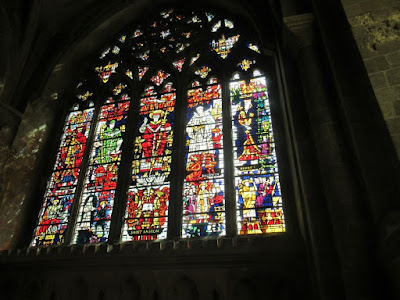Once again this is a city with a variety of architecture in its streets.
The Canterbury War Memorial is located outside the entrance to the Cathedral. It was unveiled in 1921.
We entered the Canterbury Cathedral precinct via Christchurch Gate.
A cathedral has been at Canterbury since Saxon times. In 597 St Augustine baptised the English king, Ethelbert in the Canterbury church. In Norman times the church was rebuilt and has been added to and altered over the years. The Archbishop of Canterbury has been an important position in English history and at times the post of archbishop involved being an advisor to the king.
When we visited the Cathedral we observed the Boat of Remembrance. Each glass bulb represents a year of remembrance since 1918.
Beautiful flower arrangements are to be found throughout the building.
Stained glass from different periods also features throughout the building.
 |
| St Anslem window |
The Chapel of Saints and Martyrs of our Time is at the east end on the building in a section also known as the Corona.
Thomas Becket was Archbishop of Canterbury from 1162 until 1170 when he was murdered by soldiers of King Henry II. After Becket's death the Cathedral became a place for pilgrimage for centuries.
T S Eliot's play, Murder in the Cathedral, is based on the murder of Thomas Becket. When I was in sixth form we studied this play and attended a performance of the play at St Paul's Cathedral in Melbourne - a moving experience.
Geoffrey Chaucer's work, Canterbury Tales, contains stories told by pilgrims on their way to Canterbury.
The lit candle on the floor marks where Shrine of Thomas Becket stood from 1230 to 1538 when it was destroyed on the orders of King Henry VIII.
This area is known as the Martyrdom and contains a memorial to Thomas Becket in the north west transept where Thomas was murdered.
One of the features of Canterbury Cathedral is the Crypt, an enormous space beneath the main church. It is maintained as a place of silence with no photography allowed. A special place.
We then entered the Great Cloister dating back to when the building was a monastery.
Shields representing families who donated money to the building of the monastery.
Part of the ceiling in the Chapter House.
One of the stained glass windows in the Chapter House.
On the way back to the coach we passed more interesting buildings including
this book shop. Above the door are written the words "... a very old house bulging out over the road ... leaning forward, trying to see who was passing on the narrow pavement below ... " Charles Dickens, 1849. The words are taken from the book, David Copperfield, where Dickens' character was describing a house. It is also an apt description for this building.




















No comments:
Post a Comment